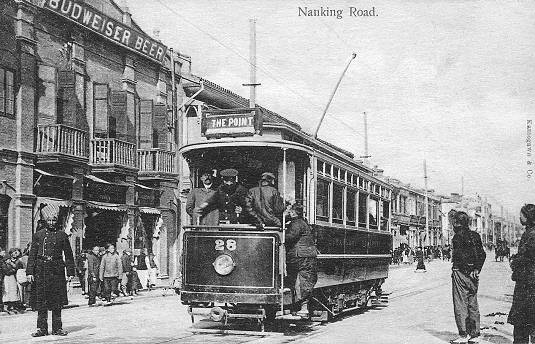

The city of Shanghai sits at the mouth of the Yangtze River close to the eastern seaboard of the People's Republic of China. A town of that name was already known there nearly 1000 years ago. For centuries it has been a major shipping and trading centre but the 19th century saw it opened and developed for foreign trade after the First Opium War. The Treaty of Nanking in 1842 resulted in settlements being established, predominated by the Americans, British and French, but also including German and some Japanese influences. By population, it is now the largest city in China and the largest in the world. At the end of the 19th century, in 1898, the city was already large enough to warrant interest in tramway proposals and these were formulated by a Franco-British enterprise, the Shanghai Tram Syndicate.
The 'international' nature of Shanghai eventually resulted in not one but three tram operating companies whose lines partly overlapped and were not restricted to their 'national' areas. It was not until 1906 that construction started and the British system was the first to open with a 6km line from the Bund to Jingan Temple in March 1908 (both 5th and 15th have been recorded in different sources) as "Shanghai Tramways" (The Shanghai Electric Construction Co. Ltd.), which was to be the most extensive with, ultimately, seven routes and 216 trams in the large International Settlement. In the smaller French Concession, "La Compagnie Francaise de Tramways et d'Eclairage Electrique de Changhai" started services in May 1908 and had three routes with 60 trams. In the Chinese part of the city just to the south of this, trams of the "Chinese Tramways Company" (Chinese Electric Power Co. Ltd.) started on 11th August 1913, and operated four routes with 52 trams. Routes were added or extended over several years, reaching their maximum in 1925 with a combined total of 328 tramcars and 14 routes.
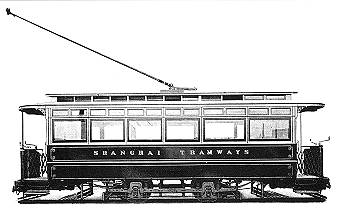 The tramways ran on metre gauge track with conventional overhead current collection. The three companies obtained their trams from various sources with the British choosing traditional 4-wheel single-deck cars built by the Brush Electrical Engineering Company Limited in their Falcon Works at Loughborough, England, as in our main title image. This batch of sixty-five trams was a similar design to the twenty type E cars supplied by Brush at the same date to London's Metropolitan Electric Tramways for their Alexandra Palace line. The original livery was dark green and light cream. The postcard shows car 28 in Nanking Road going to The Point, the terminus far to the north-east and close to the International Settlement boundary. The card was published by Kamogawa & Co. and sent to Belgium, bearing a postmark of the German post office in Shanghai, but of indecipherable date. Note that the tram here was 'front entrance' and 'rear exit'. In this period and up to 1946, the rule of the road in China was to drive on the left, hence left-hand running for the trams. Note also the Indian policeman on the left of this view. The small side view (above left) is taken from the manufacturer's catalogue of 1912.
The tramways ran on metre gauge track with conventional overhead current collection. The three companies obtained their trams from various sources with the British choosing traditional 4-wheel single-deck cars built by the Brush Electrical Engineering Company Limited in their Falcon Works at Loughborough, England, as in our main title image. This batch of sixty-five trams was a similar design to the twenty type E cars supplied by Brush at the same date to London's Metropolitan Electric Tramways for their Alexandra Palace line. The original livery was dark green and light cream. The postcard shows car 28 in Nanking Road going to The Point, the terminus far to the north-east and close to the International Settlement boundary. The card was published by Kamogawa & Co. and sent to Belgium, bearing a postmark of the German post office in Shanghai, but of indecipherable date. Note that the tram here was 'front entrance' and 'rear exit'. In this period and up to 1946, the rule of the road in China was to drive on the left, hence left-hand running for the trams. Note also the Indian policeman on the left of this view. The small side view (above left) is taken from the manufacturer's catalogue of 1912.
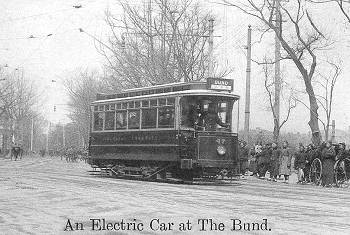 Our next view (right), extracted from a postcard published by Nippondo of Shanghai, shows similar car 47 when new in 1908 at The Bund - a wide embankment and thoroughfare bordered by jetties on the Yangtze River side and many hotels, banks, consulates and clubs on the opposite side of the road. It was also a major tramway terminal and passenger transfer point. The writer of the card refers to "Shanghai's latest requisition in 1908".
Our next view (right), extracted from a postcard published by Nippondo of Shanghai, shows similar car 47 when new in 1908 at The Bund - a wide embankment and thoroughfare bordered by jetties on the Yangtze River side and many hotels, banks, consulates and clubs on the opposite side of the road. It was also a major tramway terminal and passenger transfer point. The writer of the card refers to "Shanghai's latest requisition in 1908".
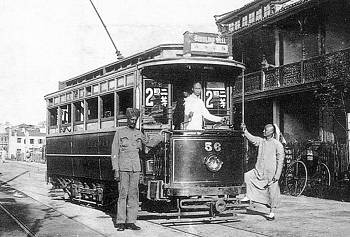 At least in the earlier days, cars were partitioned to provide first- and second-class seating. Some trams, principally for the Chinese workers, were designated as third-class. This small view of car 56 (left) is extracted from a modern card and clearly shows the 2nd class designation.
At least in the earlier days, cars were partitioned to provide first- and second-class seating. Some trams, principally for the Chinese workers, were designated as third-class. This small view of car 56 (left) is extracted from a modern card and clearly shows the 2nd class designation.
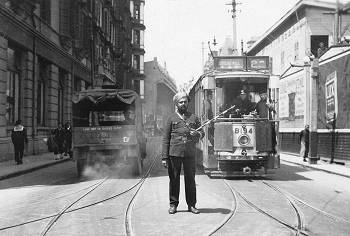 By the 1920s, trams carried supplementary letters to their numbers, 'B' for British and 'F' for French. Also by this time, a fleet of simple, centre-entrance , four-wheel trailers had been introduced.
By the 1920s, trams carried supplementary letters to their numbers, 'B' for British and 'F' for French. Also by this time, a fleet of simple, centre-entrance , four-wheel trailers had been introduced.
Our card of B194 (right) shows a British company car on route 2 to the quaintly named Bubbling Well terminus at the western end of the system. Note again the Indian policeman on traffic duty.
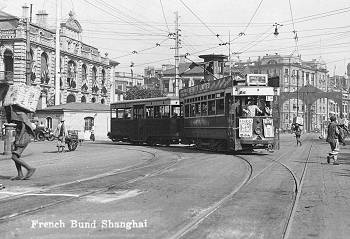 Our final card (left) shows French car 13F, probably of British origin, with trailer turning from Rue Du Consulat onto the French Bund (Quai de France) on route 1 with the French Concession 'border gateway' to the British section in the background at the junction with Avenue Edward VII.
Our final card (left) shows French car 13F, probably of British origin, with trailer turning from Rue Du Consulat onto the French Bund (Quai de France) on route 1 with the French Concession 'border gateway' to the British section in the background at the junction with Avenue Edward VII.
Each system had its own depots. On the British system, one was close to the Bubbling Well terminus, another at the western end of Yangtszepoo Road and one further east in Baikal Road, these last two being to the north-east of the city centre and the latter for use of trolleybuses. The French company depot and power station were on the southern edge of the French Concession at the junction of Avenue Dubail and Zi Ka Wei. The Chinese company depot was just to the south of Shanghai's South Railway Station. The Japanese invasion of 1937 during the Second Sino-Japanese War and the resulting Battle of Shanghai caused large sections of the British company tramway to the north-east to be cut off and damaged. A 1939 service map of tram and trolleybus routes of this area simply says, "No service in operation at present due to circumstances beyond the company's control"!
The tramway was never modernised and still had a 1930s feel in 1975 when it was closed, having been phased out from August 1963. Many of the routes were replaced by extending the trolleybus system, which has its own interesting history. It started in 1914 under the same company as the 'British' tramway system, and grew to be one of the world's largest with nearly 1000 vehicles and over 20 routes. Today, but with a very much reduced fleet, it is still one of the largest trolleybus systems and is certainly the oldest still in operation.
A new 'tramway' opened in 2010 at Zhangjiang, east of the main city centre. It is a French 'Translohr' system which is essentially a rail-guided (central single rail) rubber-tyred bus or trolleybus with overhead current collection but has the outward appearance of a modern articulated tram. Unsurprisingly for such a mega-city, Shanghai also has an extensive and expanding metro system that opened its first route in 1995.
However, the old Shanghai tramway has not completely disappeared. A circular line, with two replica "old trams" built by the Dalian Tramways Co. in 1998, can be found and visited at the Shanghai Film Park in the Chedun Town district. You can also take a ride via YouTube and travel round a section of 'old Shanghai' that has been rebuilt for filming purposes.
![]() Go to Postcard Of The Month Index
Go to Postcard Of The Month Index